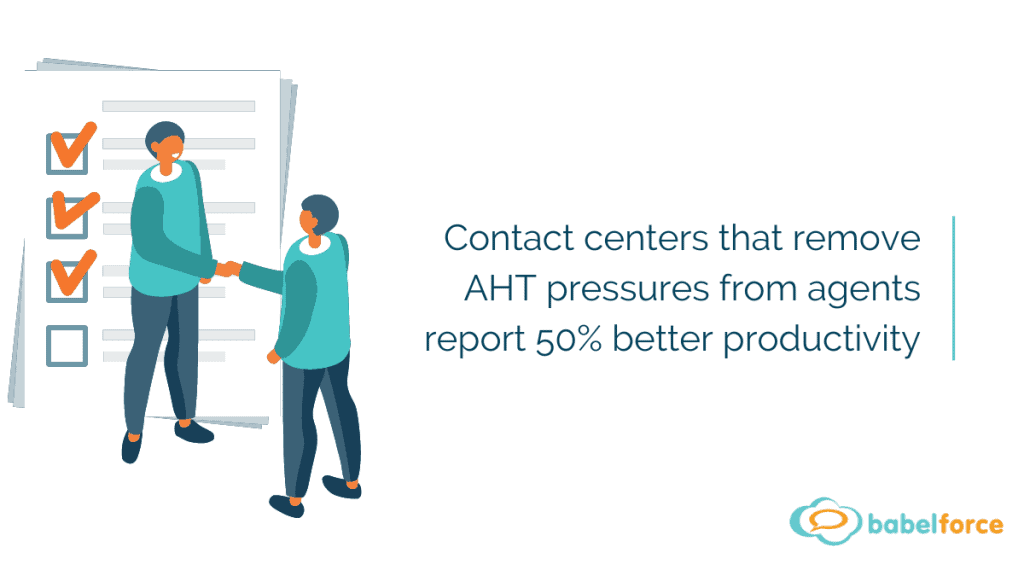In this post:
- Average Handling Time
- Customer Satisfaction
- Service Level
- First Contact Resolution
- Call Abandonment Rate
- Percentage of Calls Blocked
- Call Transfer Rate
- Wrap-up Time
- Customer Effort Score
- Average Idle Time
There are plenty of metrics and KPIs you can track to gain useful insight into your contact center operations.
But it’s easy to get bogged down in numbers if you track too much. Do you really need to keep tabs on both hold time and wait time, or will one of these numbers do?
With this in mind, here are the ten call center metrics that many experts agree are absolutely vital.
They’re enough to provide insight into all aspects of your contact center – from efficiency to customer experience and agent productivity – without overwhelming you with data.
Top Ten Call Center Metrics
#1 Average Handling Time
Average handling time (AHT) measures the average time it takes agents to complete a call.
The timer starts when a call is routed to an agent and stops when that agent has finished after call work. You don’t track time spent on hold or time in IVR.
The metric is invaluable because agents who resolve calls more quickly can help more customers in total.
In theory, you’re achieving more with your resources.
But cutting AHT too far can negatively impact customer experience. You have to balance being fast with providing great support.

How to improve AHT:
There are plenty of ways to improve AHT without causing your agents to scrimp on service.
Well-placed call center automations are one of the most effective solutions.
The right automation will help you:
- Bring up customer information for agents when they answer the call
- Take care of time-consuming manual work like data entry
- Intelligently route customers to the agents who are best suited to help
These types of automation don’t only speed up calls; they also help agents improve the service they offer.
If you want more ideas for cutting AHT, this article has you covered.
(Check out our eBook on contact center automation for even more tips!)
#2 Customer Satisfaction (CSat)
CSat is a crucial CX metric that gauges how customers truly feel about your service.
You measure CSat by sending customers a short survey, often post-interaction, that asks them to measure the experience on a scale.
(There’s no uniform scale for CSat; businesses tend to measure from 1-5 or 1-7 – it doesn’t matter too much, so long as you stick to one scale consistently.)
You then calculate the percentage of interactions that resulted in satisfied customers (for example, those rated 4 or 5) to get an average score.
How to improve CSat
The key is finding out why people leave interactions feeling dissatisfied.
The easiest way to get this knowledge is to ask what customers liked or disliked about the experience.
Typical things people dislike about contact centers include excessive hold time, hard-to-navigate IVRs, and agent transfers.
(Of course, this feedback is only useful if you can do something about it! The solution is the ACAF customer feedback loop.)

#3 Service level
Service level measures the percentage of calls answered within an acceptable amount of time, defined in advance.
Many contact centers aim to answer 80% of calls within 20 seconds.
The metric is a good measure of agent productivity. It can also show when you need to take steps to help your team; for example, by hiring staff or adding self-service resources.
How to improve service level
To improve service level, you need either more agent availability or fewer calls.
You can solve the first problem with improved scheduling or reducing AHT, while deflecting calls to self-service will help with the second.

#4 First Contact Resolution
First Contact Resolution (FCR) is the percentage of tickets – whether calls or chat – that agents resolve in a single response.
It’s important because having to call back multiple times results in a frustrating customer experience.
How to improve First Contact Resolution
Better training helps agents provide more informed service. And intelligent call routing is a good way to ensure customers speak to the agent best placed to solve the problem.
The real key is providing agents with the space they need to focus on FCR. Prioritizing alternative metrics like AHT can stop agents from taking the time they need to solve an issue adequately.
#5 Call Abandonment Rate
Call abandonment rate is the percentage of callers that quit waiting while on hold.
It’s an essential metric because customers who abandon don’t get a solution to their problem.
This has a substantial negative impact on the customer experience!
Remember that some abandoned calls are likely to be mistake dials. Because of this, many contact centers don’t include calls abandoned within 10 seconds of entering the queue.
How to improve call abandonment rate
Improving call abandonment means taking steps to reduce the time customers wait.
Helping agents answer calls faster will help. You can achieve this through better scheduling or improving AHT.
Another option is to set up a virtual queuing system. This allows you to arrange customer callbacks during busy times, so customers don’t have to wait on hold.
#6 Percentage of calls blocked
This measures the percentage of callers that receive a busy tone when they dial.
You clearly want this number to be as low as possible, as every blocked call is a missed opportunity to help a customer.
How to reduce the percentage of blocked calls
There are a few approaches to lowering the percentage of calls blocked, including:
- Virtual queuing
- Scheduling more agents
- Using a blended agent model
- Reducing AHT
- Improving self-service provision

#7 Call Transfer Rate
Call Transfer Rate is the percentage of calls that get transferred from one agent to another.
Sometimes transfers are necessary and unavoidable. But a large number of transferred calls tends to imply one of two problems.
- Your agents don’t have the right training to help customers
- You’re routing isn’t taking customers to the right agents
How to reduce call transfer rate
Better routing is the easiest way to improve this metric. It increases the chance of the customer speaking to the agent best suited to solve their problem.
Intelligent routing systems and improving the effectiveness of your IVR will help.
Another option is to improve call center collaboration. This allows agents to get help from other team members without actually transferring the call.
T-Mobile famously encourages call center collaboration through shared workspaces and an instant messaging platform.
After making these changes, transferred calls at the company dropped – as did cost to serve, call escalation, and even agent turnover.
#8 Wrap-up Time
Wrap-up time shows the time agents spend on post-call work. This can include activities like data entry, writing summaries, or sending documents.
Some wrap-up time is inevitable. But the longer it takes, the less time agents have to spend helping customers.
How to reduce wrap-up time
Automating post-call work is an effective way to reduce wrap-up time. You can automate tasks like sending documents and manual data entry.
Creating processes for tasks you can’t automate will also help. For example, you could build message or summary templates for agents to use.
Encouraging agents to perform some wrap-up work during a call will also help. For more ideas, check out our article about how to reduce wrap-up time.

#9 Customer Effort Score
Customer Effort Score (CES) is a metric that aims to measure how easy it is for customers to resolve an issue.
A good score suggests it was easy, while a bad score indicates that interacting with your team was a grind.
This is important because customers with a low effort score say they are more likely to make a repeat purchase than those with high scores.
Low-effort interactions also cost 37% less than high-effort ones.
Calculate customer effort by asking customers to rate how easy their interaction was post-call on a scale of 1 to 7. Then calculate the average score across all interactions.
How to improve your Customer Effort Score
Improve customer effort by streamlining the customer experience.
Consider making support available on more channels, improving your self-service resources, and proactively anticipating (then solving) customer issues.
#10 Average Idle Time
Average idle time is the amount of time agents spend waiting for calls. Idle time is unproductive – a high score suggests you may be paying more than necessary for labor.
But, it’s not a good idea to reduce idle time too far. Doing so can lead to agent burnout and will affect your ability to answer calls quickly.
Most contact centers aim for around 15% idle time.
How to get a better idle time balance
Operating a blended call center is an excellent way to balance idle and working time. This is because agents can make outbound calls when incoming call volume is low.
Offering omnichannel support is another option. Agents who aren’t dealing with live contact can focus their time on asynchronous channels such as email.
The Right Metrics Provide Essential Visibility
These call center metrics provide visibility into all parts of your business. You can track the customer experience, call center efficiency, and agent productivity.
The key for many businesses is getting a balance between all three factors.
For more ideas, check out this article which contains 21 different call center KPIs you can track.





